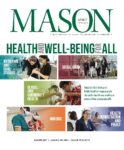 Interdisciplinary work, in the classroom and in the research laboratory, has always been a hallmark of George Mason University. We appreciate interdisciplinary endeavors and believe that breakthroughs most likely will come not from the core of a discipline but at the boundaries between the disciplines.
Interdisciplinary work, in the classroom and in the research laboratory, has always been a hallmark of George Mason University. We appreciate interdisciplinary endeavors and believe that breakthroughs most likely will come not from the core of a discipline but at the boundaries between the disciplines.
Cutting-edge programs, such as our new degrees in bioengineering, environmental and sustainability studies, and computer game design, would not be possible without the willingness of faculty to collaborate outside their units.
My own career reflects this crossing of disciplines. I was a math major and earned my graduate degrees in computer science. After working in numerical methods and computer sciences, I became a business school professor and dean.
One of the reasons the interdisciplinary concept works so well is thanks to Provost Peter Stearns and our deans. The deans deserve a lot of credit for creating an environment where these collaborations can take place. Although they highly respect each other, that doesn’t mean they don’t challenge each other, because they do. But I would rather have bucking broncos that are often hard to control than mules that are hard to move.
The deans at Mason were hired because they are strong academics—and have a certain amount of bucking bronco to them. They see the benefits of supporting each other. Being willing to let their faculty teach and collaborate outside their respective school or college a takes certain amount of trust.
Interdisciplinary work is riskier because it is often hard to evaluate. Most often, the academics you see engaging in this kind of work are in the middle phases of their career having already made significant strides within their discipline.
Physical placement can also enhance and foster interdisciplinary research. In fact, there’s organizational theory that speaks to how people are more likely to work together if they are in physical proximity to each other, and as you move them away from each other, the amount of collaborative work drops off as the interactions become less frequent. I wasn’t surprised when I heard that our researchers at the Center for Applied Proteomics and Molecular Medicine and the National Center for Biodefense and Infectious Diseases, both housed on the Prince William Campus, were working together and receiving funding for joint research projects.
One of the things that drive interdisciplinary work is interaction with the nonacademic world. When faculty members are out there banging up against real-life issues, they find themselves making connections between the disciplines to solve problems.
If this were the kind of university where they were cloistered and rewarded for just their individual research and scholarship, we wouldn’t see these collaborations happening as frequently as they do. We also wouldn’t see as much ground-breaking research and innovative ideas contributing to solving societal problems and creating new courses and degree programs.
Alan G. Merten
President, George Mason University

No Comments Yet »
Leave a comment